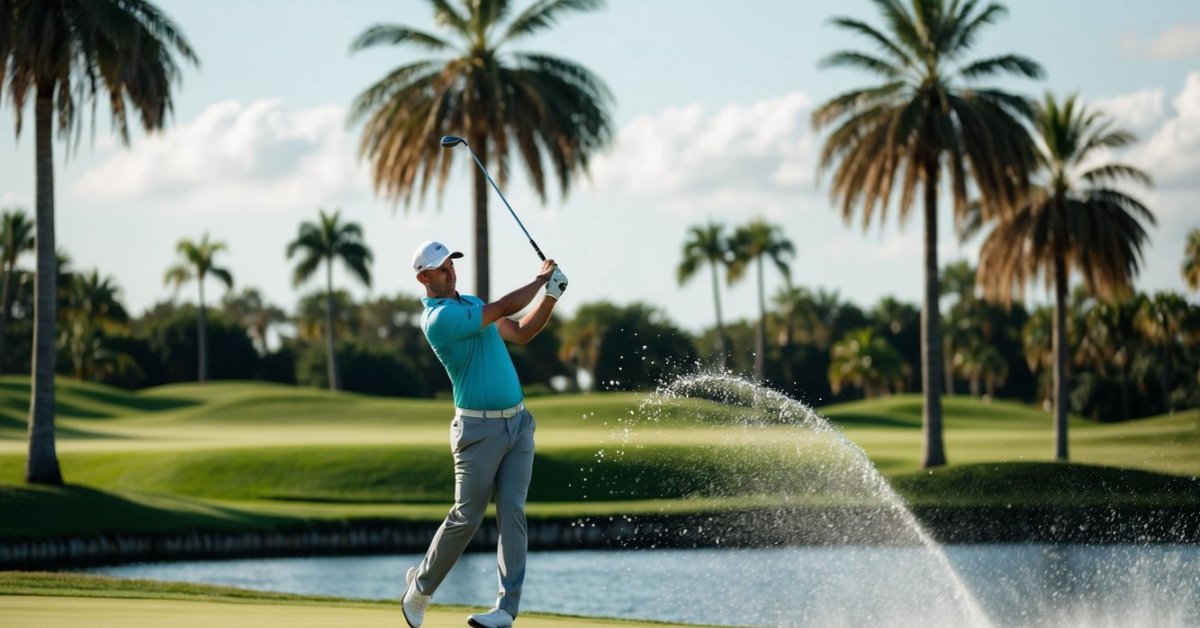Ever lost sight of your golf ball against the clouds or struggled to spot it on a sunny day? You’re not alone. Choosing the right golf ball color can make a world of difference in your game.

In this article, we’ll dive into which golf ball colors stand out most against the backdrop of the sky. Whether you’re looking to improve your visibility on the course or just curious about the science behind color perception, you’re in the right spot.
Importance of Golf Ball Color Visibility
When you’re swinging your clubs on the fairway, the visibility of your golf ball is more than just a convenience—it’s a strategic advantage. Not only does it save time during your search after a long drive, but it also keeps your momentum going, which is key for maintaining focus and rhythm during your rounds.
Think about the moments you’ve spent squinting into the sky, trying to locate that tiny white speck. Now imagine replacing that speck with a color that catches your eye like a beacon. That’s what choosing the right golf ball color can do for you. It’s not just about personal preference; visibility can actually impact your game performance.
- Brightly colored golf balls are easier to track in the air.
- High visibility balls may help you gauge your swing speed better.
Contrast is at the heart of this visibility game. Your ball will spend a considerable amount of time in the air set against the backdrop of the sky. Whether it’s a clear blue, a murky gray, or even a downcast twilight hue, the right color ball can stand out amidst these varying conditions, ensuring you never lose sight of your shot.
Moreover, consider the psychological aspect. There’s something to be said for the confidence boost you get when you can effortlessly keep your eye on the ball. Not having to second-guess where your ball landed allows you to approach your next shot with certainty, with your strategy firmly in place. And let’s not forget, using a distinctive colored ball can speed up play, reducing the frustration that comes with prolonged ball searches, which not only benefits you but your playing partners as well.
Remember, choosing a golf ball color isn’t just a matter of aesthetics. It can mean the difference between a good shot and a great one. By selecting a color that stands against the sky, you’re giving yourself a visual aid that complements your skills on the golf course.
How Color Perception Affects Visibility
When you’re lining up your drive or approaching the green, the last thing you want is to lose sight of your golf ball against a backdrop of sky, trees, or rough. Your ability to see colors can significantly affect how well you spot a ball in flight.
The human eye is sensitive to objects that stand out from their backgrounds. For example, a white ball might seem like a good choice on a sunny day, but once it soars into the bright sky, it can become nearly invisible. That’s due to the lack of contrast, especially when the ball is backlit.
« What Is Golf Ball Diver? Unveiling the Underwater Heroes of Golf Courses
Have you ever noticed that fluorescent colors seem to pop more than others? This heightened visibility comes from these colors’ ability to reflect more light, making them appear brighter to the eye. It’s the same reason traffic cones and safety vests are fluorescent. When you see a fluorescent yellow or orange ball, it’s not just bright; it’s scientifically more visible thanks to the higher wavelength of color creating a stark contrast against the greens and blues of the golf course environment.
Research into golf ball visibility has illuminated a few key points. Darker colors like blue or black can be quickly lost in the shadows or the deep blue of a clear sky. Brighter colors such as pink, orange, and yellow stand out better, particularly on cloudy days or during twilight hours when light conditions aren’t as intense. Even the color of the grass you’re playing on can influence how easily you can spot the ball.
Time spent searching for a hard-to-find ball is frustrating and can throw off your game. Using science to your advantage, you can select a ball color that’ll save you time and help keep your focus sharp. Remember, every second you’re not searching for your ball is a second you can use reading the green or visualizing your next shot. So, consider how your eyes perceive color the next time you’re selecting a golf ball for your game. It’s a small detail that can have a noticeable effect on your performance.
Factors to Consider When Choosing a Golf Ball Color
When you’re walking down the golf aisle looking for the perfect ball, it’s not just the brand or the price that should catch your eye. The color of your golf ball plays a critical role in how you play the game. It’s not about fashion—it’s about visibility. Let’s dive into what you need to consider when selecting the best color for your golf experience.
Brightness is your ally on the course. In general, the brighter the ball, the easier it is to spot in the sky. You’ve probably noticed that traditional white balls can be tough to track on a cloudy day, while a vividly colored ball stands out.
Next up is the contrast factor. You want a ball that contrasts sharply with the surroundings. In the case of a clear blue sky, an orange or pink ball can be much easier to spot than a white or green one. Likewise, on a green fairway, a dark blue ball could blend in too easily.
Ever think about the seasons? They matter more than you might realize. During fall, when the leaves are a mix of browns, reds, and yellows, you’d want to ditch those colors in favor of a ball that can be quickly distinguished from the foliage. In winter or spring, with more barren landscapes or blooming flowers, your perfect choice might change again.
Don’t forget the role of personal preferences and psychological comfort. Some players find certain colors more appealing and comforting, which can translate into better play. If you find a particular hue that seems to improve your focus and confidence, that’s a huge plus.
Here’s a little tip: before you settle on a hue, give a few different colors a test run during your practice rounds. Pay attention to how they behave against various backdrops and in different light conditions. You’ll soon find your own sweet spot for the best color that complements your game, making those mid-air tracks effortlessly smooth.
Which Color Golf Ball is Easiest to See in the Air?
You know that split second when you lose sight of your golf ball against the clouds or the bright sky? Choosing the right color for your golf ball can be a game-changer in those moments. When you’re driving the ball down the fairway, you want to track the ball’s flight from the moment it leaves your club.
Orange and yellow golf balls are often touted as the easiest to see in the air. These colors offer a sharp contrast against the blue sky and are bright enough to stand out during the flight. But it’s not just a simple choice between two colors; you’ve got different shades to consider.
Neon variants of these colors, like neon orange or neon yellow, can make it even easier for you to keep an eye on your ball. The brightness of neon colors is hard to miss, even in overcast conditions or when the ball is soaring above sunlit clouds. Many golfers find that these vibrant options help improve their focus during the flight of the ball, providing an edge in tracking the ball’s trajectory and landing spot.
Let’s not forget the condition of the course as well. If you often play courses with lots of greenery, an orange ball can be a standout choice as it contrasts well with the greens and fairways. On the other hand, if you’re playing a course with autumn colors or sandy areas, a yellow ball might be your best bet for visibility.
Experimenting during practice rounds is key to finding what works best for you. Different lighting conditions and backgrounds can affect visibility, so it’s worth trying out various colors in situ. Some golfers even match their outfit to their golf ball color to maintain a visual theme and focus.
Remember, the primary objective is to enhance your visibility of the ball in flight, which could potentially lead to fewer lost balls and better scoring. Keeping track of your ball’s trajectory will help you make better choices for your next shot and could be crucial in shaving strokes off your game.
Tips for Improving Golf Ball Visibility
When you’re on the course, ensuring your golf ball stands out against the vast expanse of fairways, roughs, and hazards is crucial. Visibility is not only about the color of your ball but also how you keep track during its flight.
Mark Your Ball with a unique symbol or pattern using a permanent marker. This not only distinguishes your ball from others’ but also helps you lock in visually as it soars across the course. Opt for bold shapes or a high-contrast color for the mark; it’ll act as a beacon when you’re scanning downrange.
Keep Your Eyes Fixed on the ball from the moment you address it until after your follow-through. Losing sight, even for a second, can mean a lost ball or a costly drop in strokes. As obvious as it sounds, maintaining a steady gaze will train your eyes to become better at tracking under various conditions.
Use High-Visibility Golf Balls that come with built-in visual aids. Some balls have lines and patterns that, in addition to their bright color, can really pop in the air. It’s not just about aesthetics; these designs can significantly enhance your ability to follow the ball.
Enhance contrast by choosing the right Apparel and Accessories. Believe it or not, wearing dark shades helps the neon-colored balls stand out more. Think of it as a backdrop for your ball’s bright flight. Sunglasses with contrast lenses can also be a game-changer, especially on glaring sunny days or during the late afternoon when the sun starts to set.
Lastly, Track Your Ball Against Landmarks if you can. Aligning your ball’s flight with a particular tree, bunker, or edge of the fairway provides a point of reference for your eyes to follow and helps in locating the ball upon landing. This spatial awareness can be the difference in keeping your ball in sight and out of trouble.
Remember, these small adjustments in how you prepare and track can have big impacts on your game, especially since a ball you can see is a ball you can play. Keep experimenting with different tips and find what works best for you out there on the links.
Conclusion
Frequently Asked Questions
How can I improve my golf ball visibility on the course?
Mark your golf ball with a unique symbol or pattern using a permanent marker, watch it closely throughout your swing, consider using high-visibility golf balls with visual aids, wear dark shades to enhance contrast, and use landmarks as reference points to keep track of it better.
What benefits can marking my golf ball provide?
Marking your golf ball can help you distinguish it from others on the course, making it easier to track in flight and identify when searching for it, which can help speed up play and reduce frustration.
Why should I keep my eyes fixed on the golf ball during my swing?
Keeping your eyes fixed on the ball helps maintain focus and coordination during the swing, enabling a more accurate shot and making it easier to follow the ball’s trajectory after hitting it.
Are high-visibility golf balls really different from regular golf balls?
Yes, high-visibility golf balls are specifically designed with bright colors and patterns to stand out against the green of the course, providing visual aids that make them easier to follow during flight and locate on the ground.
How do dark shades enhance contrast on the golf course?
Dark shades filter out excess light and reduce glare, which can enhance the contrast between the golf ball and the background, making the ball stand out more to your eyes on sunny days.










